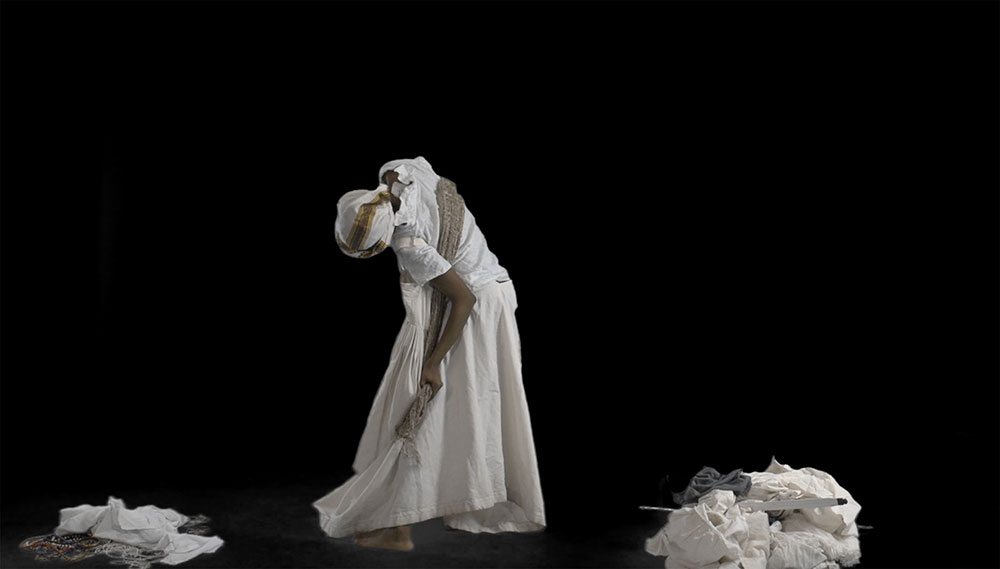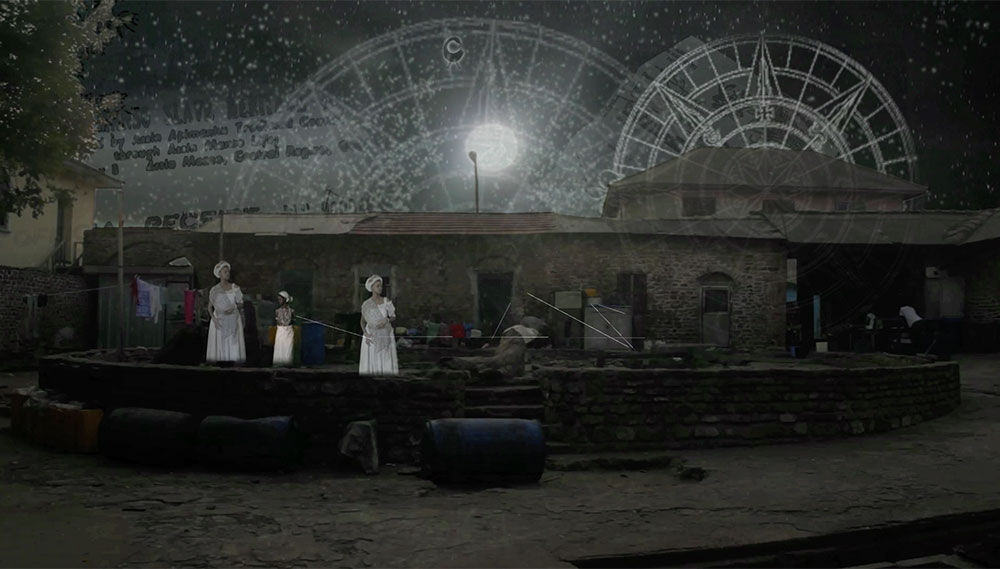Sakhile&Me presents "I Was Her and She Was Me…", a duo exhibition which brings together works by Kitso Lynn Lelliott and Tuli Mekondjo that engage history, memory, and both tangible and intangible archives through a variety of media, including embroidery, photography, performance and the moving image. The exhibition runs from 4 August 2022 until 11 September 2022 and will include primary source materials as well as a recommended reading list. ¹
The exhibition includes two video works by Kitso Lynn Lelliott: "I was her and she was me and those we might become," which the title of the exhibition borrows from, as well as "My story no doubt is me/Older than me." In both works, the artist can be seen appearing and vanishing from view, oft-times in a white dress, a ghostly figure and ethereal presence that emerges in several of the artist’s films, transporting a time in the past into the present moment and becoming a kind of untethered portal.
"I was her and she was me and those we might become" contains no audio and runs in a meditative silence for 20 minutes. On the other hand, "My story no doubt is me/Older than me" is shorter, lasting only 5:56 minutes, and opens in black screen with the artist’s voice firmly stating that "my story no doubt is me, but it is also, no doubt, older than me" before switching to a silent outdoor scene bustling with activity: children playing, figures appearing and disappearing including a figure in a white dress, at first centered in the screen and then off-center and eventually transposed in large scale and hovering above the scene. The daily scene is overlaid with a celestial sky, stars scattered all across the screen until the view is altogether overtaken by what appears to be large geometric star charting symbols in the night sky. Turning back to the daily scene, the narration also returns and closes the short with the words, "..no end, no middle, no beginning. No start, no stop, no preparation. No backwards, no forwards. Only a stream that flows into another stream – an open sea."
Lelliott’s spoken words in the second film are gathered together like grains into a basket by her writing on this piece, which begins with a quote by Saidiya Hartman, "I, too, live in the time of slavery, by which I mean I am living in the future created by it." The artist goes on to add, "I have been thinking about how deep time/history has this intimate proximity to and everyday intimacy with the present that has come out of it. I was trying to reckon with the daily getting on with life in the wake of and within a social world produced by mass trafficking in human beings. I did this at one of the epicentres of this foundational violence and affront to humanity that forged the social, spiritual, cultural reality that are our everyday. I was considering the exceptionally unexceptional normalcy of racial violence and the exceptionally unexceptional ways in which the coping of those violated bodies and persons goes unrecognised and unappreciated. The video was shot in one of the oldest buildings in Accra, which is now a family compound in Jamestown. The stone circle in the centre of the frame is where slaves were put on display to be sold."
With similar time-transporting effect, Tuli Mekondjo stitches past and present, bridging and in some ways creating, a time-portal between the then and now. The artist’s five large works made with collage, mahangu, resin, acrylic ink, paint marker, acrylic gold paint and cotton embroidery on canvas drape through the viewing room forming a series of portals in time. As in much of her other work, Mekondjo pays homage to and expressively positions herself in dialogue with her ancestors, referencing multiple African folklore traditions.
The large panels depict almost life-sized images of figures taken from postcards traced back to Namibia’s colonial times. Once stowed away, the artist retrieves these images and re-activates them through hand-stitching red silk thread (as the artist points out it is a material she finds interesting because it is at once fragile and yet strong) across their surfaces, creating new textured relief patterns of red lines/veins across the surface. She weaves red veins into organ shapes, eyes, wombs, unborn babies in wombs, vining through and connecting the standing figures and trailing outward to the edges of the canvas plain. The repetitive motions of embroidering the canvas by hand, meditative like the silent ethereal woman in a white dress, dressing and disrobing, swaying in and out of sight. All the while, between the moving images and the stills, the silences and the sounds, the crisp view and the ghostly overlays – there is a sense of simultaneously looking within and stargazing.
Through their independent practices, Lelliott and Mekondjo embody remembrance, with the body as a vessel through which past self/selves and/or ancestors come to life and the lives they lived echo into the present, their ghostly presence leaving traces behind. The translucent overlay and time-lapse technique in Lelliott’s films also mirrors the photo transfer stills in Mekondjo’s works creating an echo-like ripple effect, as though these recalled memories and past lives continue to reverberate, creating a living energy field and leaving expansive vibrations or even sonic trails behind. Manually transferring memories through film or archived photographs of ancestors onto canvas and altering the seemingly foregone states or fixedness into fluid and changeable states –transformed by the artists’ own hand and words.
Kitso Lynn Lelliott is based in Johannesburg, South Africa. An artist, scholar and filmmaker, her research and studio practice excavates and/or interrupts historical instances of elision, usually having to do with renegotiating and enunciating omitted knowledges, histories or narratives. Oscillating between what is ‘real’ and revealing erasure, the artist often embodies or motions at instances of retrieval, at times lending her own body in the retelling or re-articulation of said instances.
Tuli Mekondjo is based in Windhoek, Namibia. She is self-taught visual artist who employs mixed media including embroidery, photo transfer, paint, resin and mahangu (millet) grain and draws on colonial and war-time photographic archives and on histories of change, loss and submission – with a particular focus on women. In addition to embroidered canvas and paper works, Mekondjo’s practice increasingly involves live performance in which the artist becomes a channel between past and present. Tuli Mekondjo is represented by Guns&Rain in Johannesburg and Hales in New York City.
¹ The research nook contains source materials and readings, including original archival postcards Tuli Mekondjo references in her work and book recommendations on history, photography, and the archive, such as Saidiya Hartman's Wayward Lives, Beautiful Experiments: Intimate Histories of Riotous Black Girls, Troublesome Women and Queer Radicals; Nicola Brandt’s Landscapes Between Then and Now: Recent Histories in Southern African Photography, Performance and Video Art; Wolfram Hartmann et al.'s The Colonising Camera: Photographs in the Making of Namibian History; and Tina M. Campt's Listening to Images.






